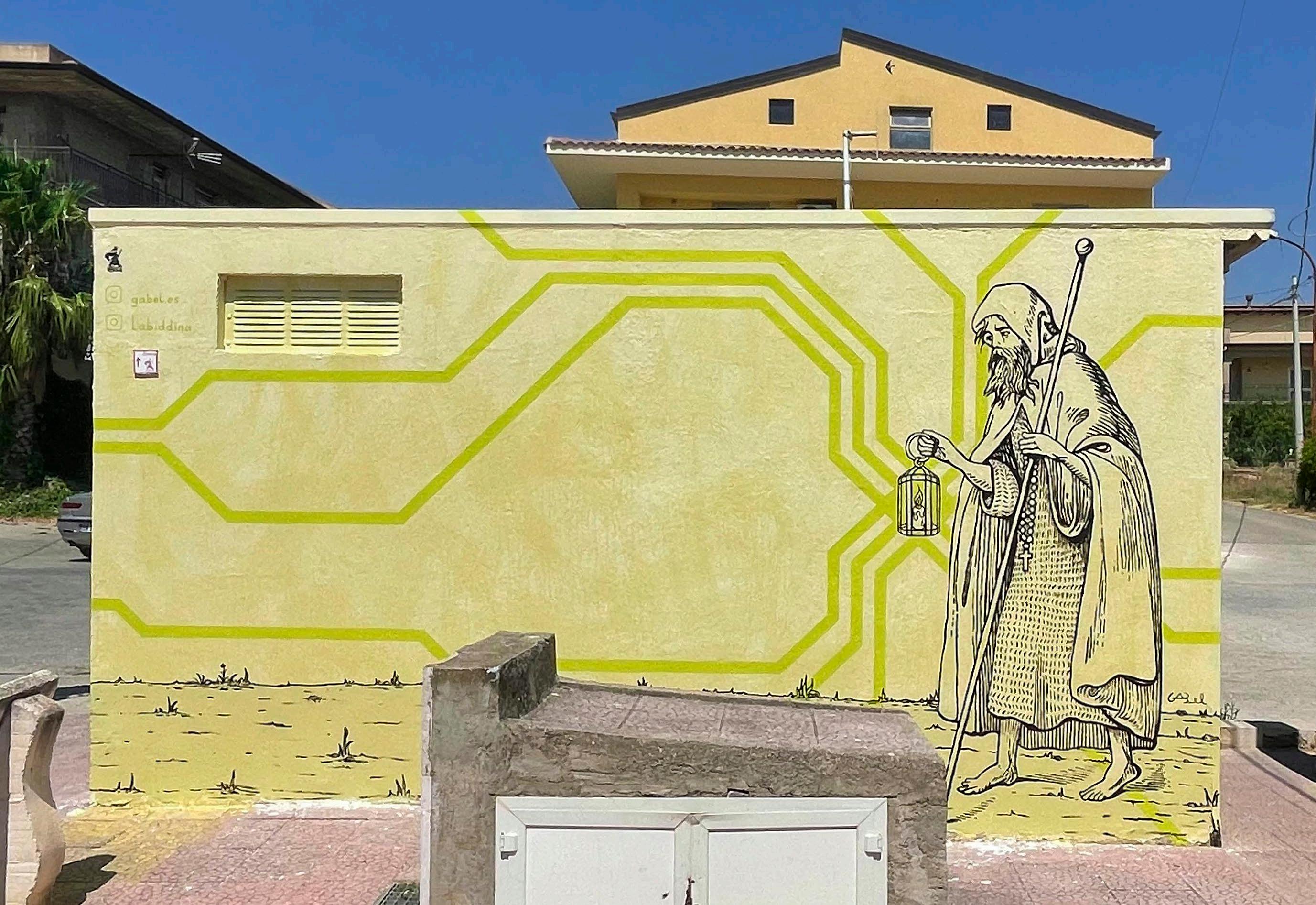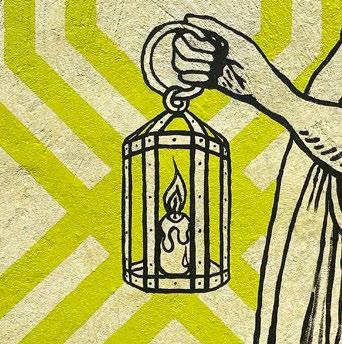





GABEL
Catania 19/04/1987
I went through the world of digital graphics and photography, and then I followed the physical and manual path of printmaking and street art. I grew up in the era of analog/digital conversion and part of my artistic work still tries to reconcile this duality.
Other seemingly opposite themes (old/new, sacred/profane, nature/technology) recur in the creative process.
In particular, I focused on the theme of the sacred, inspired by the iconography of various traditions, reinterpreting it with a new language, more in line with our times.
A logical and historical thread links together the different iconographic traditions depicted. The result is a contemporary icon, whose evocative function takes us beyond stylistic traditions and canonical symbols, to create new ones.
Technological and historical elements are essential factors in the interpretation.
The works often show this contrast between apparent opposing worlds, which once combined together, initially generate disorientation in the viewer, who tries to understand whether there is a logical and/or rational narrative meaning. This feeling gives way to an inner search for the answer. And here we come to the first phase of contemplation, an implicit function of sacred art.
Science fiction, spirituality, meditation and a bit of irony.
This is Gabel, streetartist since 2015.




Poseidon and the wave
Catania (CT), 2023
The work was created in the district called Civita in Catania, a place inhabited by generations of fishermen and sailors, which is why I chose to portray Poseidon, god of the sea for the ancient Greeks.
Classical iconography of Poseidon depicts him driving his chariot drawn by seahorses. He was often depicted together with dolphins and holding his trident, forged by the Cyclops. In many cities of Magna Graecia, celebra tions in honour of Poseidon took place at the beginning of the winter season. Sailors prayed to Poseidon to grant them a safe voyage and sometimes, as a sacrifice, drowned horses in his honour.
When he was benevolent, Poseidon offered a calm and storm-free sea; when he felt offen ded and ignored, he struck the earth with his trident, causing stormy seas and earthquakes, drowning sailors and sinking ships. Hence one of the deity’s epithets: “Enosichthon”, or earth shaker.
The famous Odysseus was also a victim of her wrath as, in order to flee from the Cyclops Polyphemus, son of Poseidon, he blinded him. The god of the sea then unleashed all his fury on Ulysses, and forced him to sail for years away from his homeland.
Finally, I hope that human beings can learn not only from seaquakes, but also from calm seas.

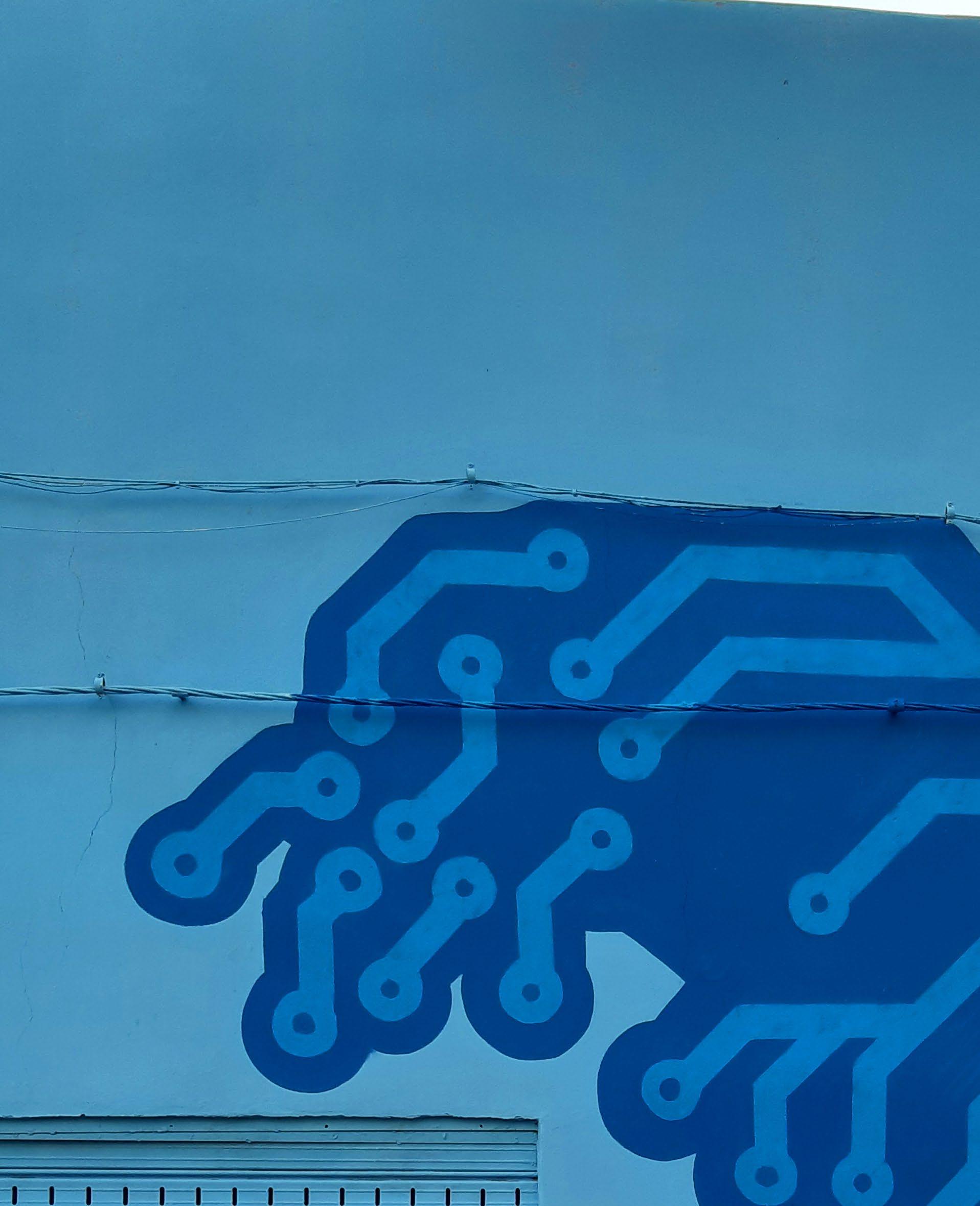


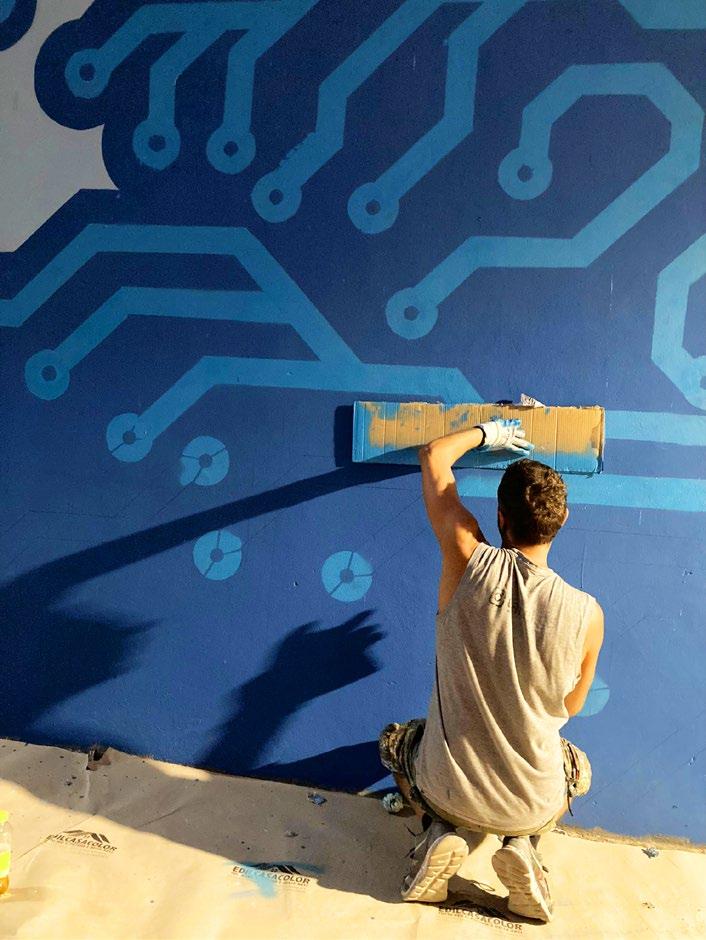


Sterope
Tripi (ME), 2022
Tripi is a village situated on a hill a few kilometers from the Tyrrhenian coast, where there are the remains of the ancient city of Abakainon, probably of Sicilian origin, then Hellenized. Placed at a height of 450 metres above sea level, it is possible to see the Aeolian Islands on the Tyrrhenian Sea.
According to the historian Maurolico, in ancient times it was called Tripium or Steropium. The name is supposedly derived from Sterope, one of the three Cyclopes, sons of Uranus (the sky) and Gea (the earth), brother of Arge and Bronte. He provided his services as a blacksmith to the god Vulcan, in the caves of the island of the same name.
Uranus and Cronus imprisoned the three brothers in Tartarus. Finally Zeus defeated Kronos and liberated the Cyclopes who became his blacksmiths, making special weapons and objects, such as the trident for Poseidon and the helmet of invisibility for Hades. Among the three brothers, Sterope was the one specialised in the production of the thunderbolts.
On our arrival in Tripi, we were greeted by a storm and several lightning strikes. Perhaps between the mountains and the sea, between Etna and the island of Vulcano, the giant Sterope still forges his thunderbolts , connection elements between the sky and the earth (Uranus and Gea).
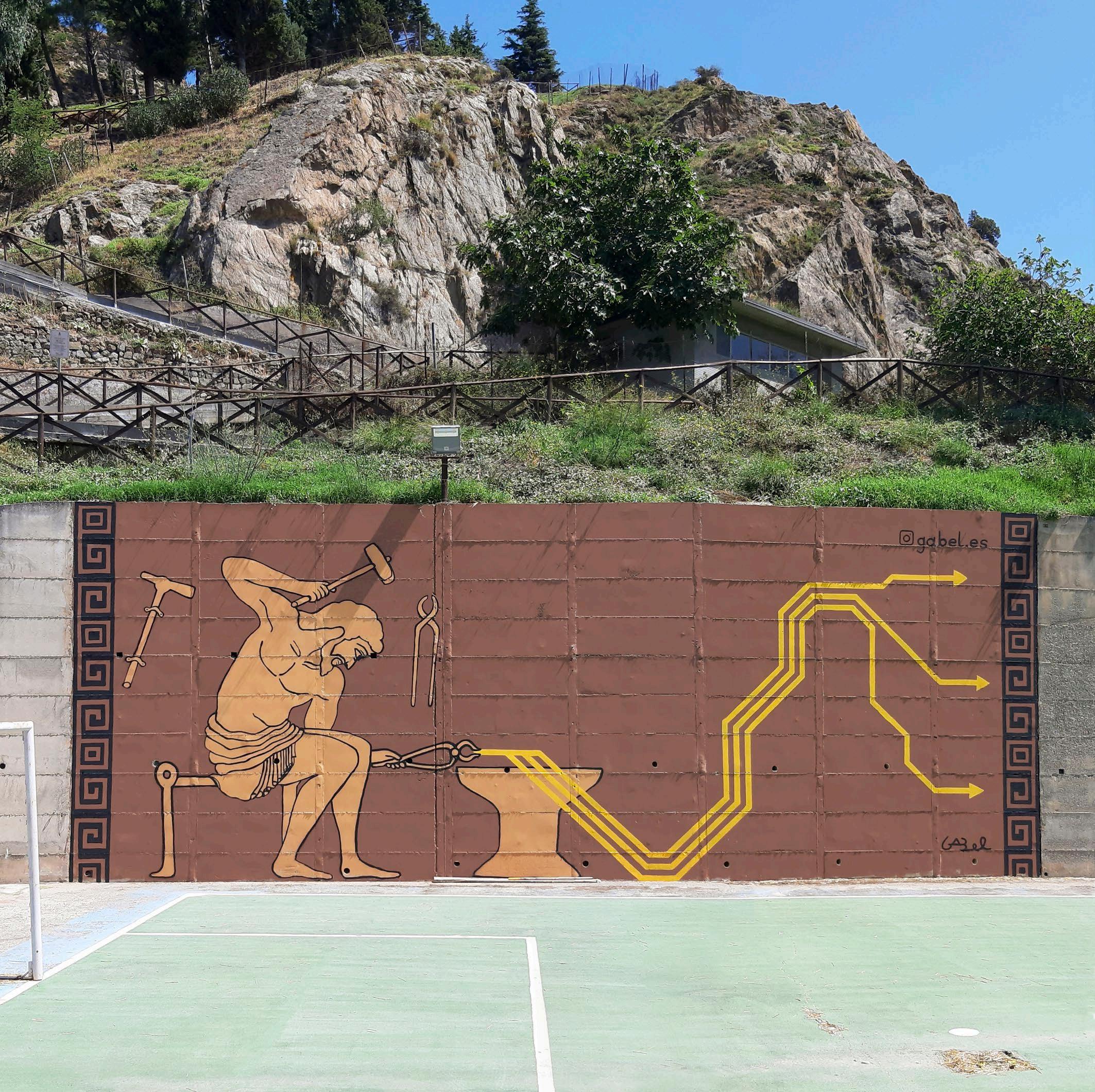



Yoga Jesus
Acquedolci (ME), 2022According to the cause-and-effect law, every action (or non-action) we take part in modifies our earthly life and our future lives (on any existential plane). The compendium of each individual’s actions or non-actions is called Karma. Accumulating a bad Karma you are relegated to the cycle of birth and death called Samsara. Instead, by acting correctly, it is possible to cleanse one’s Karma until one reaches liberation (Moksha).
Among the various types of Yoga there is Karma Yoga (from the Sanskrit Karma - action, and Yoga - union), the discipline that allows to generate positive consequences in the universe, acting with detachment, without feeling desire or aversion to the product of their actions.
If we analyze the deeds that Jesus performed during his earthly life, we notice how they are a perfect example of this discipline.
At a time when we are witnessing a clash between East and West, this work wants to be a meeting point between the two poles.


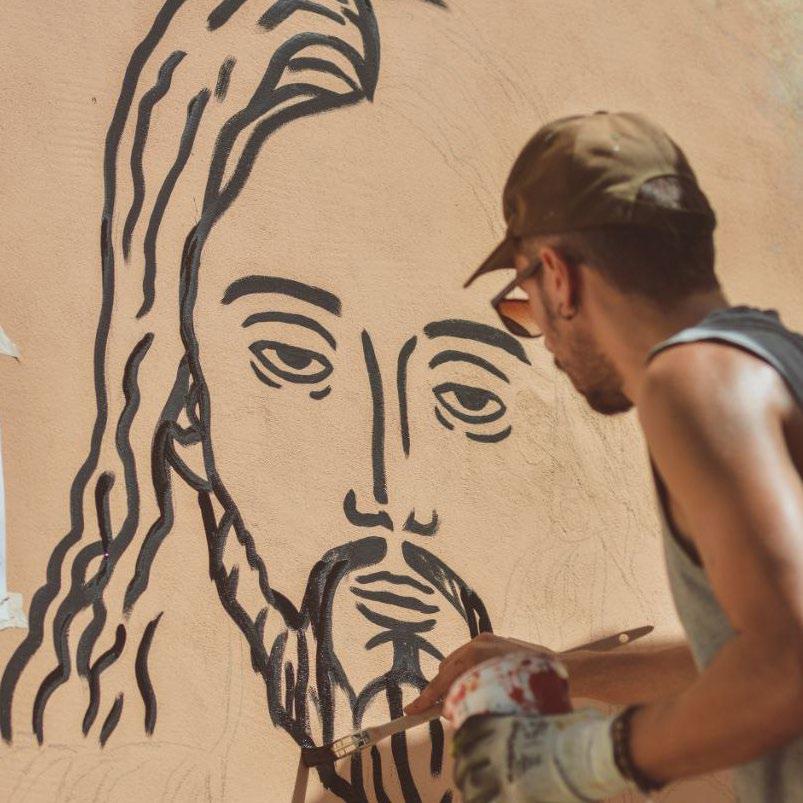




Galatea
Aci Trezza (CT), 2022In Greek mythology, she is one of the fifty sea nymphs, the Nereids, daughters of Nereus and Doris, whose task is to assist sailors. The etymology of the name seems to derive from the Greek Galàteia (Γαλάτεια), “milky”, as candid as milk. According to other interpretations it could derive from “calm” (γαλήνη), to indicate the function of goddess of the calm sea. The legend tells that Galatea was in love with the shepherd boy Aci, a beautiful young man. Cyclops Polyphemus was fascinated by the nymph and therefore envied the young shepherd.
One day he tried to lure her with the sound of his flute, but without succeeding. One evening Polyphemus saw the two lovers in the moonlight by the sea. Furious, he threw a large volcanic rock at the poor shepherd boy, hitting and killing him. Galatea wept all her tears over the body of her beloved. The blood of the shepherd boy turned into a small river called Aci (Aκις), which rises from the volcano Etna and flows into a small beach near Capo Mulini, where the two lovers used to meet. Even today many neighboring villages still have the prefix Aci, as it is said that Polyphemus scattered the parts of the body of the young man in different places.
Galatea, white as milk, goddess of the sea calm, has a lot of patience, and has managed to transform her sadness into vital energy. I address to her my most melancholic memories, now reduced to binary code, so that they may retract into something alive in the present. Like a river, may they flow back into the cosmos.




Demetra
Catania, 2022
Demeter (Ancient Greek: Δημήτηρ) is the Greek divinity of grain and agriculture, nurse of youth and the earth, creator of the cycle of the seasons, life and death, protector of the harvest and the sacred laws.
Daughter of Cronus and Rhea, sister of Zeus. She and her daughter Persephone, are related to the religious practices of the “Eleusinian mysteries”.
Demeter gave mankind the knowledge of agricultural techniques. The current name of the cereals derives etymologically from the Latin name of Demeter, “Ceres”.
According to the Athenian Isocrates, the greatest gifts of Demeter to humanity were cereals, which made man different from wild animals and the “mysteries”, which allowed him to have higher hopes than those related to mere earthly life.
In the writings of the Sicilian Theocritus there are traces of what was the role of Demeter in archaic cults: “For the Greeks Demeter was the goddess of the poppies”; “In the hands held bundles of wheat and poppies”.
Some historians hypothesize that, during the rites of the “Eleusinian mysteries”, the initiates were induced into a state of trance obtained through derivatives of the “Papaver Somniferum”. Other hypotheses refer to the fungus Claviceps Purpurea, which infects cerals.
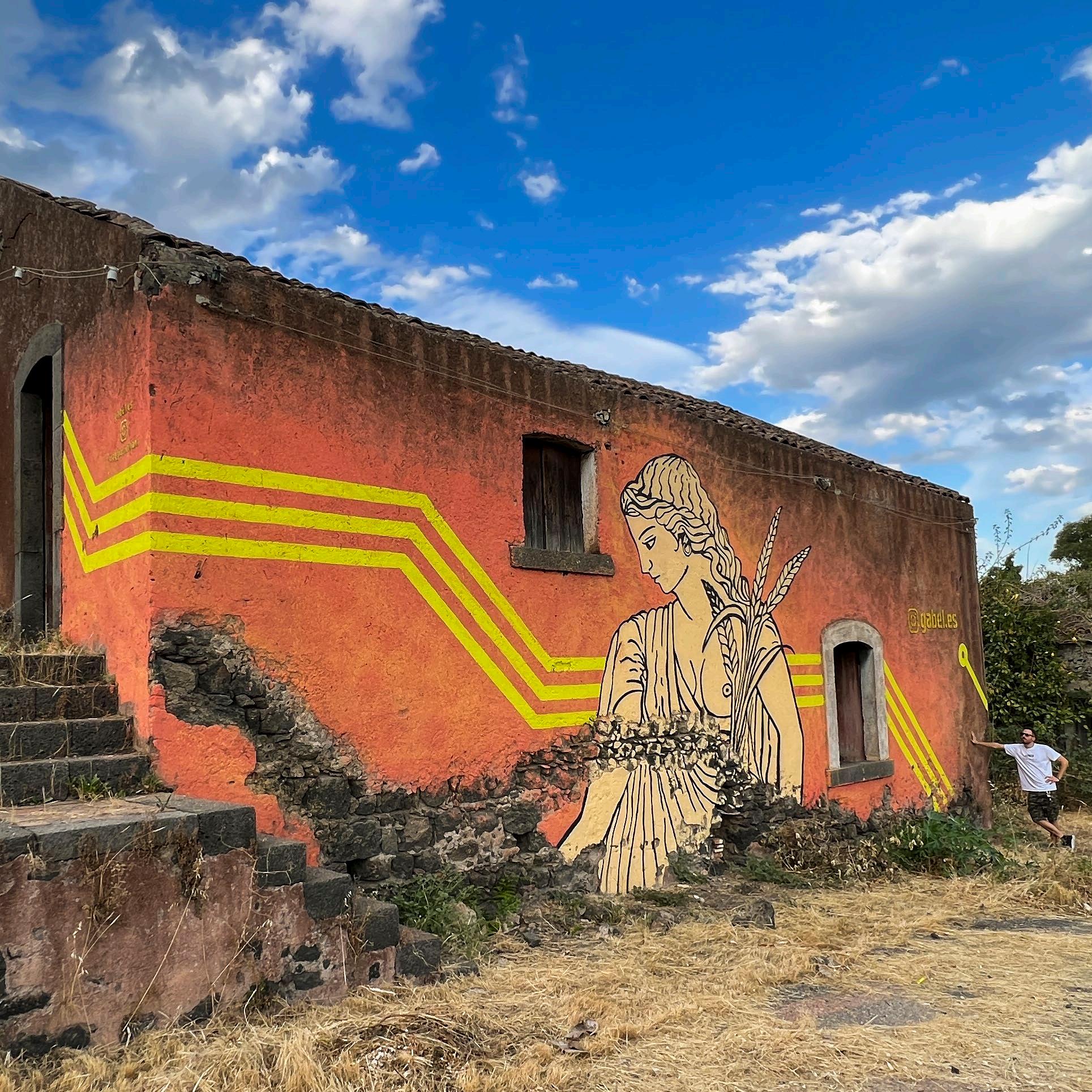



Ganesha Liotru
Catania, 2021
Dedicated to the city of Catania, which has an elephant as its symbol.
The link between the city and this animal is very ancient, from the discovery of dwarf elephant fossils to the use of war elephants during the Carthaginian domination. During the Muslim domination, the city was known by the name of Balad-el-fil (city of the elephant).
The emblem of the city comes from the statue of the Elephant Fountain, called “Liotru”. Giovanni Battista Vaccarini realized the fountain in 1735, renovating the statue of the elephant volcanic rock, of which we do not know the historical origin. There are many myths and legends about the origin of the statue, it is said that it was the remnant of an ancient religion of which traces have now been lost.
The cult of this animal is present especially in India, where the elephant-headed deity is called Ganesha.
In classical iconographies, Ganesha is always slightly fat to represent abundance. The Prasad (sacred food) never fails.
In one hand he holds a snare, a symbol of union, in the other an axe to sever obstacles and desires, bearers of suffering.
In India when the elephants decide to enter the rice fields to eat, there is no way to stop them, so Ganesha is also called the Lord of obstacles.
Next to him is always a mouse, symbolizing ego, greed and fear (it is said that elephants are afraid of mice). It is always depicted as his servant, or even being ridden by Ganesha, who uses it as a vehicle, symbolizing the predominance of wisdom over fear.
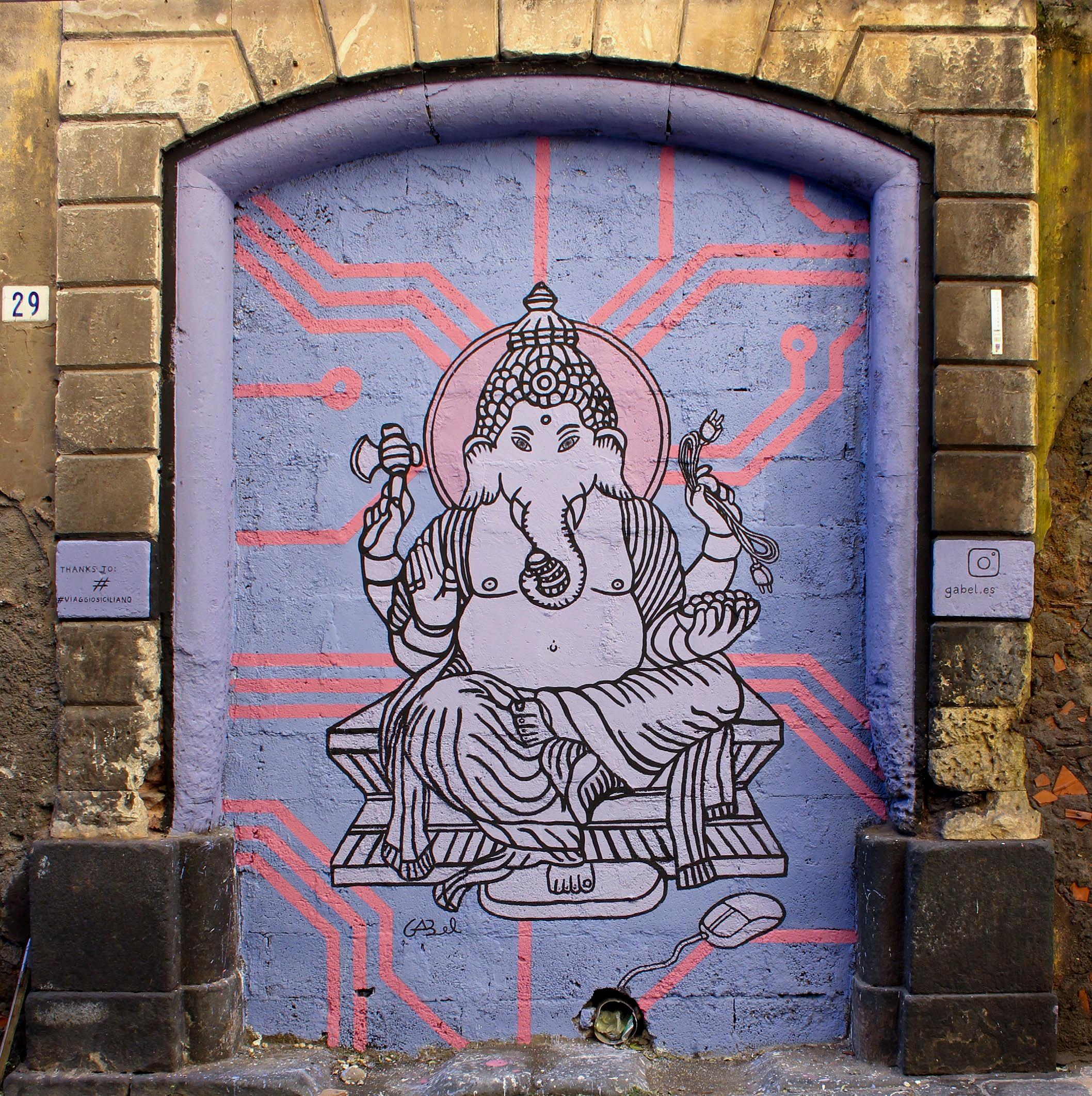



Madre Celeste
Aci Castello (CT), 2021Aci Castello is a very special place, where you can find a castle built on a lava cliff that rises on the sea.
Regarding the historical origin of the building, it is usually attributed to the Normans, but it seems that the first building is attributed to the Byzantines around the seventh century.
Just below the castle there is a small port, now almost disused. The structure I worked on, was part of an old bathing establishment, abandoned for years.
Initially I was choosing a subject of Greek inspiration, then I realized that when I started it was the 19th, my mother’s birthday. The theme then shifted to Christian motherhood. Jesus said he was the Alpha and the Omega, the beginning and the end. In numerology this translates into numbers 1 and 9.
The celestial recalls the sky, the circuits therefore suggest a connection between heaven and earth. The subject inspired by the Byzantine iconographic tradition is a tribute to the historical origin of the castle.



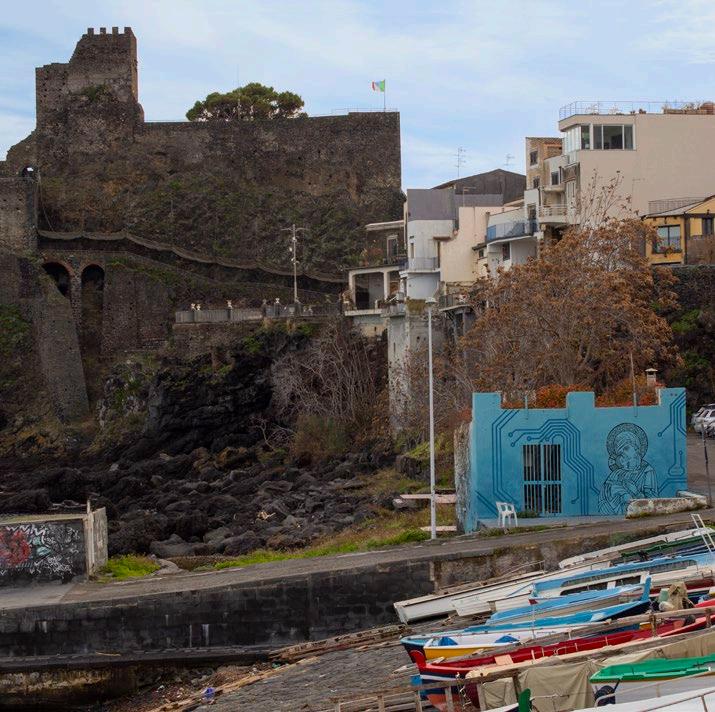



Narciso 2022
Sciacca (AG), 2022
Narcissus was a young hunter of Greek mythology, famous for his beauty. Son of the nymph Liriope and the river god Cephissus, in the myth he appears incredibly cruel, as he rejects every person who declares love to him. When, looking out into a body of water, he saw his reflection, he was mesmerized and fell madly in love with it. He leaned so far that he fell into the water and, because of a divine punishment, died.
At the point where he fell, a flower of the genus “Narcissus” was found, derived from the Greek narkē (numbness), which refers to the content of alkaloids or the intoxicating smell of these plants.
The substantial difference in this Narcissus dated 2022 AD, is that the young man is mirrored in a tangle of circuits floating in water, in which he mistakenly recognizes himself. Narcissus 2022 falls in love with his avatar and is punished by the karmic laws that turn him into a flower.

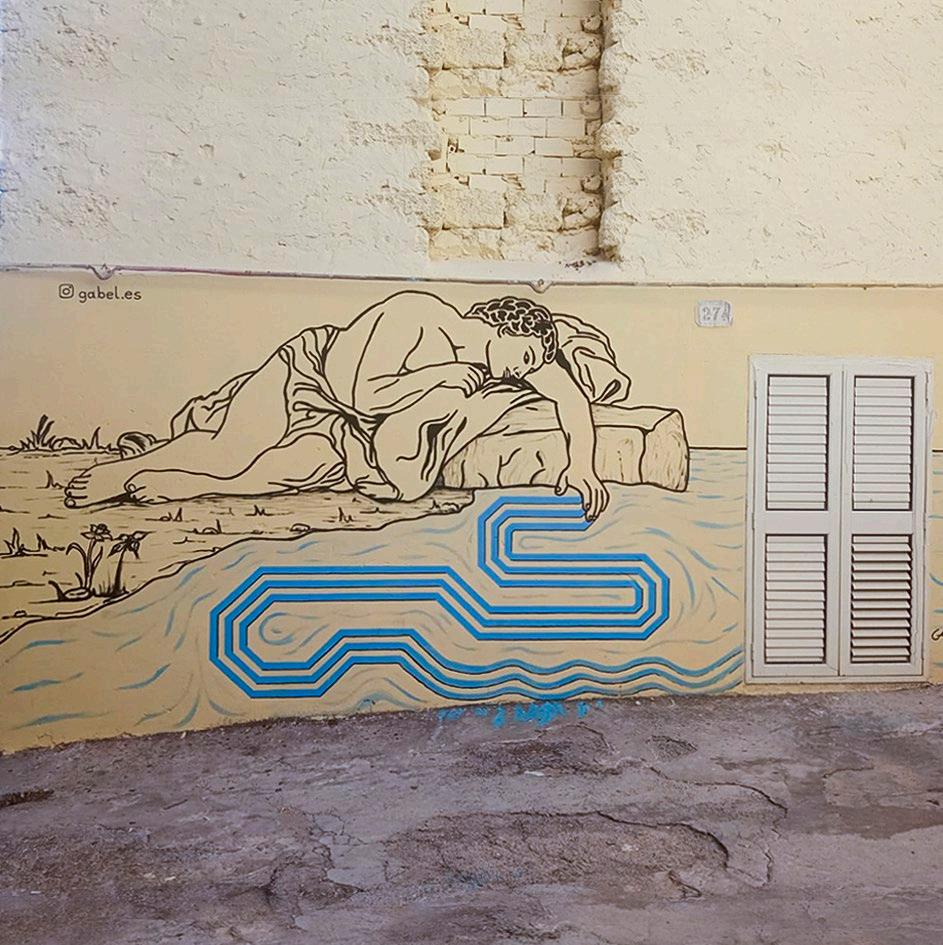


Il Pellegrino
Joppolo Giancaxio (AG), 2022This town in recent years has become a destination for pilgrims thanks to the rediscovery of the Magna Via Francigena, a route that since antiquity crosses Sicily, connecting Palermo to Agrigento.
The project, curated by the association La Biddina and promoted by the municipal administration through the Participatory Democracy, involves the transformation of an electrical substation into an artwork. This, being along the path of the pilgrims who go to the inhabited center, has a welcoming function.
The pilgrimage can connect us with the divine, disintegrating the ego through physical and mental effort.
It is interesting that even Francesco da Paola, patron saint of the city, has been a hermit for most of his life.
The key is light, understood as knowledge. On every path there are always dark moments in which you do not know what to do and it is easy to lose the way. The pilgrim has a lantern that helps him move in the darkness. This, wants to represent technology, which must act as a support to the human being, during the journey, to reach the goal, and not replace the goal itself.
In the journey you are often alone and, even if you meet various fellow travelers, each journey is individual and unique, but they all lead to a goal.
